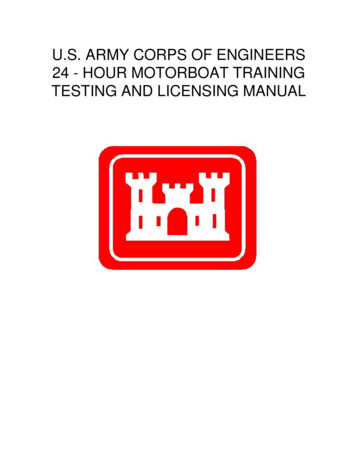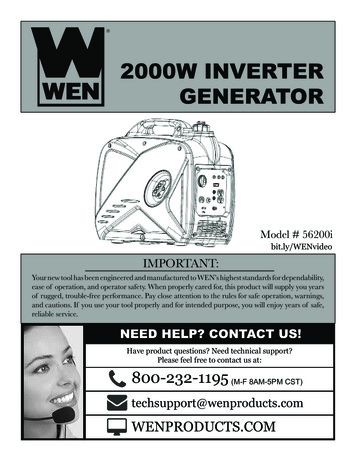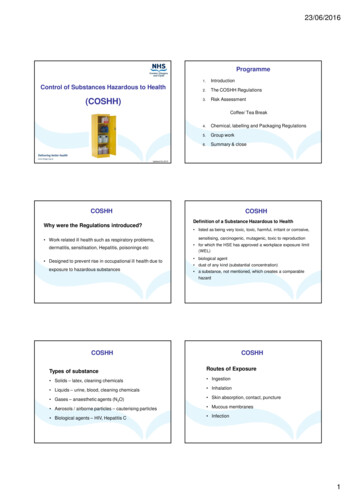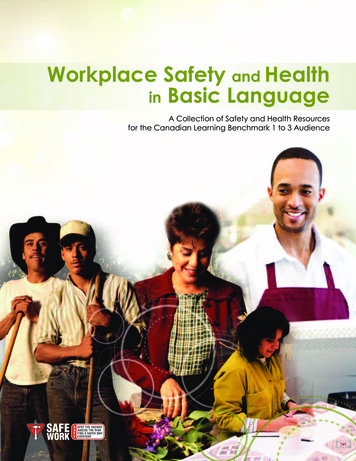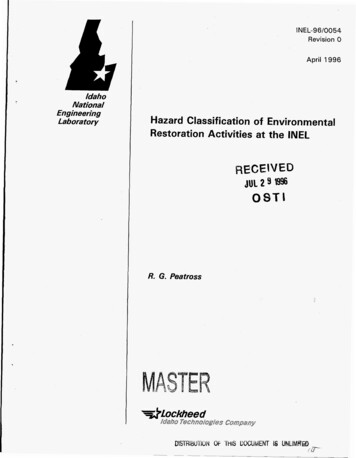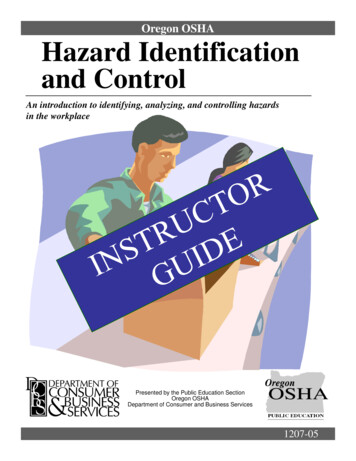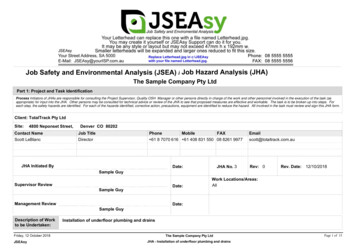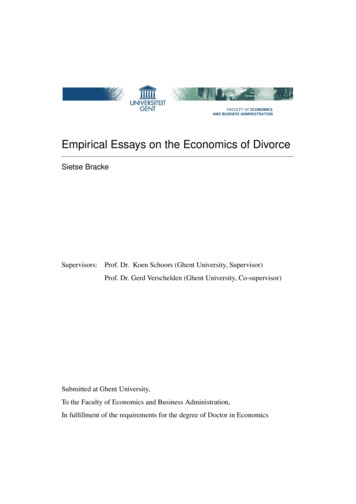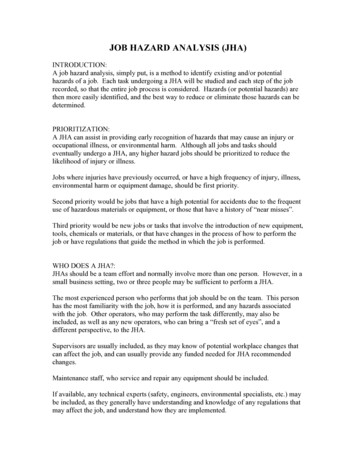
Transcription
Activity Hazard Analysis (AHA)
Activity Hazard Analysis (AHA) AHAs: Risk Assessment ToolDefines the Activity or Work to be PerformedIdentifies HazardsEstablishes Controls to Reduce the Hazard toan Acceptable Risk LevelLiving Document Changes with Site Conditions or OperationsChanges of competent/qualified personnel
Contractor Required – AHA(New Format)
Contractor Required - AHA EM 385-1-1, para 01.A.13.a: AHAs shall define the activities being performed andidentify the work sequences, the specific anticipated hazards, site conditions,equipment, materials and the control measures to be implemented to eliminate orreduce each hazard to an acceptable level of risk. EM 385-1-1, para 01.A.13.b: Work will not begin until the AHA for the work activityhas been accepted by the Government Designated Authority (GDA) and discussed withall engaged in the activity, including the Contractor, subcontractor(s), and Governmenton-site representative at preparatory and initial control phase meetings. EM 385-1-1, para 01.A.13.c: Identify the names of the Competent/Qualified person(s)required for a particular activity as specified by OSHA and EM 385-1-1. (i.e.,Excavation, Fall Protection, Scaffolding, etc.) EM 385-1-1, para 01.A.13.d: AHAs shall be reviewed and modified as necessary toaddress changing site conditions, operations, or change of competent/qualifiedpersonnel. **Living document**
How to Develop Site SpecificAHAs - Six Step Process Step 1: Identify: Definable Features of Work Reference Contractor Quality Control PlanContractor Project Schedule Subcontractors and suppliers working on the project shallalso contribute in developing an accurate “ProjectSchedule”.Within each “Definable Features of Work” there maybe other sub-phases of work to complete the“Definable Features of Work” such as Set-up/Demobilization of office trailersStaging of construction materialsDemolition of walls, HVAC systems, etc.Asbestos/Lead abatement activities
Definable Features of WorkExamples of “Definable Features ofWork” from start to finishWithin each “Definable Features ofWork” there may be other subphases of work to complete the“Definable Features of Work”For Example: MobilizationSub-phases: Placement of project field office Utilities tie-in Erection of project fencing Establishing lay-down areas Environmental controls Erection of USACE project sign Etc.Identify “Definable Features” ofwork from start to finish
Definable Features of WorkList “Definable Features of Work”and sub-phases of work on AHAs under“Job Steps:For Example:MobilizationPlacement of project field officeUtilities tie-inErection of project fencingEstablishing lay-down areasEnvironmental controlsErection of USACE project sign
Hazards Step 2: Identify: Recognized or anticipated hazards for each definableand/or sub-phases of work Ask yourself the following to help identify hazards (not allinclusive): Is there a danger of the employee of being struck by something (fallingobjects, moving equipment, etc.) from above, side, behind or in front?Can the employee slip or trip?Can the employee be caught in or between objects, machinery,collapsing walls, confined space, etc.?Strains or sprains?Electrical shock?Can the employee fall from same or different levels?Can employee or equipment come into contact with overhead lines orunderground utilities?Can employee be exposed to hazardous environments or chemicals?Utilize past experiences, Lessons Learned, After ActionReports, Accident Trends, common sense, etc. to helpidentify hazards
HazardsList “Hazards” on the AHAs under “Hazards”Examples of Hazards (not all inclusive)::Struck ByStruck by Falling ObjectStruck AgainstFall on Same LevelFall on Different LevelSlipped/ Tripped (No fall)Punctured ByLacerationCaught OnCaught ByCaught BetweenLifted, Strained by (Single Action)Contacted by (Object was moving)Electric ShockImpaledDowningOxygen Deficient AtmosphereExposed ToStung ByEquipment FailureEquipment RolloverFireCave-In
Controls Step 3: Identify: Site specific control measures to eliminate orreduce each hazard to an acceptable risk level Ask yourself the following (not all inclusive): How can the working condition or process be changed?Can the hazard be eliminated with engineering controls?What type of PPE can we use?Can the hazard be eliminated with administrative controls?What can the employee do to prevent an accident or eliminatethe hazard?Utilize past experiences, Lessons Learned, After ActionReports, Accident Trends, common sense, etc. to helpformulate control measures.GOAL: Reduce each Hazard to Acceptable Risk Level
ControlsJob StepsHazardsControlsMobilization:Project field office placementStuck by movingequipmentFall from elevatedheightsUtilities tie-inWear reflective vests.Establish “No Zone” with flagging orbarrier tape. Authorized personnelonly!Back up alarms.Operators maintain eye contact withspotters at all times.Provide ladder for safe access to roof.Personnel shall wear full body harnesswith lanyard.Install manufacture approved anchorpoint at least 6 ft (1.8 m) from the roofline.100 percent tie-off at all times.RAC
Competent/QualifiedPersonnel Step 4: Identify: Names of the Competent or QualifiedPersonnel required for the activity or job step Reference EM 385-1-1OSHAProof of competency/qualification shall be submitted to theGDA for acceptance prior to start of workAttached competency/qualification documentation to AHAExamples of Competent/Qualified Personnel ExcavationScaffoldingFirst Aid/CPRElectricalConfined Space
Competent/Qualified Personnel Names of the Competent orQualified Personnel required for theactivity or job step ReferenceEM 385-1-1OSHA Attached competency/qualificationdocumentation to AHA
Risk Assessment Code (RAC) Step 5: Identify: Risk Assessment Code (RAC)Review each “Hazard” for “Probability” and“Severity” per Risk Assessment Code Matrix chart Probability: Likelihood of the hazard to cause a incident,near miss, or accident Frequent - Occurs very often, known to happen regularlyLikely - Occurs several times, a common occurrenceOccasional - Occurs sporadically, but is not uncommonSeldom - Remotely possible, could occur at some timeUnlikely - Can assume will not occur, but not impossible
Risk Assessment Code (RAC) Step 5 con’t: Severity: Outcome/degree of the incident, near miss, oraccident Catastrophic - Death or permanent total disability; Majorproperty damageCritical - Permanent partial disability or temporary totaldisability; Extensive damage to equipment or systemsMarginal - Lost workdays due to injury or illness; Minordamage to equipment or systems, property, or theenvironmentNegligible - First aid or minor medical treatment; Slightequipment or system damage, but fully functional orserviceable; Little or no property or environmental damage
Risk Assessment Code (RAC) Step 5 con’t: Ask yourself: How often (probability) will this hazard result ina incident, near miss, or accident? For Example: Ask yourself: What will be the outcome or degree (severity) ofinjury or property damage if the incident, near miss, or accidentdid occur on site? For Example: Employee falling from roof or elevated heights (Hazard)Probability: OccasionalBroken arm or leg with lost time (outcome or degree)Severity: MarginalReview “Risk Assessment Code (RAC) Matrix” chart to determineRisk Assessment Code (RAC) as E, H, M, or LRAC: M (Moderate Risk)
Risk Assessment Code (RAC)Probability: OccasionalRisk Assessment Code (RAC) Moderate Risk (M) Identify (M) as RAC for the hazard on AHA Repeat RAC process for each hazardSeverity: MarginalM
Risk Assessment Code (RAC)Job StepsMobilization:Project field office placementHazardsControlsRACStuck by movingequipmentWear reflective vests.Establish “No Zone” with flagging or barriertape. Authorized personnel only!Back up alarms.Operators maintain eye contact with spottersat all times.LFall from elevatedheightsProvide ladder for safe access to roof.Personnel shall wear full body harness withlanyard.Install manufacture approved anchor point atleast 6 ft (1.8 m) from the roof line.100 percent tie-off at all times.MMost RACs will be (M) or (L) after safety controls have been identified, but some RACsmay be classified as (H) or (E) after safety controls have been identified. See next slide.
Risk Assessment Code (RAC) Step 5 con’t RACs that are E (Extremely High Risk) or H (HighRisk) after safety controls Contact ET, CME, AROICC and FEC Safety Office (QA, PE, or REto include CEPOJ-SO for CoE) for assistancePotential E or H activities or job steps Contractor diving operationsEntry into Permit Required Confined SpacesHot Work on or around fuel systemsCritical lift crane opsReview and approval from CI5, PAC Safety, A/E, PM,(Construction Chief, AE, E&C Chief, PPMD Chief, AE, SO Chief,DD, or DE for CoE) (when necessary)
Risk Assessment Code (RAC)Job StepsHazardsControlsRACDevelop critical lift plan IAW EM 385-1-1,para 16.H.Submit critical lift plan to GDA foracceptance and review plan with all involvedwith the lift.Inspect rigging.Detail rigging planVerify wind speed prior to liftInspect crane prior to useLoad test craneHMechanical WorksInstallation of new 200 ton HVACcooling towerLoss of load duringcrane liftRACs classified as (H) or (E) after identifying safety controls may requireadditional review and acceptance from Field Office, SO, or Command groupleaders. Seek guidance or instruction from GDA before start of work.
Equipment, Training, andInspection Step 6: Identify: Equipment to be Used, TrainingRequirements, and Inspection Requirements Reference: EM 385-1-1OSHA 29 CFR 1926Manufacture Instructions/Recommendations (OperatorManual)Industry PracticesUtilize past experiences, Lessons Learned, After ActionReports, Accident Trends, common sense, etc.Communicate with subcontractors, suppliers, etc.
Equipment, Training, andInspectionEquipment to be UsedExcavatorGeneratorScaffolding (Frame or TubeClamp?)Full body Harness with LanyardPortable Toilets5 Ma GFCIPower Cord SetsCraneFirst Aid KitSafety ShoesSafety GlassesHardhatRespiratory ProtectionFire ExtinguisherTraining Requirements30 OSHA Construction SafetyIndoctrination TrainingFirst Aid/CPRFall ProtectionDaily Tool Box Meetings (Japan)Weekly/Monthly Safety TrainingRespiratorEmergency Response ProceduresQualified Crane OperatorQualified Heave EquipmentOperatorQualified ElectriciansQualified Scaffold ErectorsInspectionRequirementsSSHO/QC Daily Site InspectionsScaffoldingShoring Systems for ExcavationMonthly First Aid KitsFall Protection PPE and AnchorsAll Heavy EquipmentPower Cord Sets (Daily)GFCIs (at least Monthly)Grounding (Monthly)
Conclusion Construction work is inherently dangerousAHAs are a risk management tool to help identifyhazards or risks and formulate controls to reduce thehazard to an acceptable risk levelCommunicate with subcontractors, suppliers,PWD/ROICC field office personnel, etc. when developingAHAsAHAs shall be reviewed and modified as necessary toaddress changing site conditions, operations, or changesof competent/qualified personnelContact Safety Office for assistanceSafety requires a TEAM EFFORT!
Activity Hazard Analysis (AHA) AHAs: Risk Assessment Tool Defines the Activity or Work to be Performed Identifies Hazards Establishes Controls to Reduce the Hazard to an Acceptable Risk Level Living Document Changes with Site Conditions or Operations Changes of competent/qualified personnel
